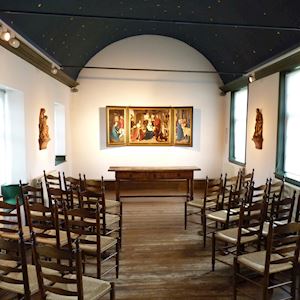
HB 05 Chapel
You are now in the castle chapel. It was built on the castle wall in 1727, which can be seen on a detailed drawing by surveyor Theodor Bucker. But as far as the building history is concerned, the only thing we know is that the work was carried out in accordance with the building plans of the German court director, Frans Anton Eppeln van de Raayhof. The timber framing we see on the outside may well have been inspired by the architecture of his home country. The extensive Huis Bergh archives reveal that the dedication of the chapel took place a year later. ‘All this to the greater honour and glory of God and the Virgin Mary’. Frans Anton van Eppeln van de Raayhof proved to be very shady character. In 1735, he burned proof of his shameful wheelings and dealings…..thereby burning down almost the entire castle. The chapel survived remarkably unscathed. After the fire, the castle was no longer lived in. It was let to the Roman Catholic church, which used it as a priest seminary. But of this, sadly no further information has survived. After the castle had been acquired by Jan Herman van Heek, there was no longer need for a private chapel. In a next great fire, the chapel was again miraculously saved.
For more information on the restoration of the chapel in the 70s and 80s, press A.


For centuries, Huis Bergh Castle was the ancestral castle of the powerful Van den Burgh counts. The castle's building history dates back to the 12th century. Jan Herman van Heek, an industrialist from Enschede, purchased the castle in 1912. He amassed a collection of late medieval artworks that are on display in the castle even today. There is also the possibility to have your (wedding)party here or stay the night in one of the luxury suits in a former defense tower.
- Hof van Bergh 8
- 's-Heerenberg Netherlands
- (0314) 661281
- www.huisbergh.nl
